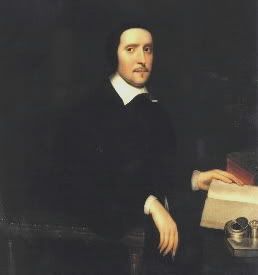
In the 1600s, manuals for practical Christian living and deepening the worship experience became very popular in the Anglican Church. One example is Bishop Jeremy Taylor's Holy Living. Section X of the book is devoted to continual "preparation to the Holy Sacrament," the celebration of which "is the great mysteriousness of the Christian Religion." Holy Living had a lasting impact on churchmen of the day. Both Wesley and Keble acknowledged its influence on them. Here is Archbishop Henry McAdoo's sumary of the chapter.
At the heart of the eucharistic mystery is the unique high priesthood of Jesus, who “sits perpetually, re-presenting to the Father that great effective sacrifice” which in our manner and proportion we proclaim “by sacramental re-presentation . . . and offer to God and re-present in this solemn prayer and sacrament, Christ as already offered.” Thus receiving Christ we offer ourselves, our obedience, and thanksgiving to the Father and so priest and people "are sacrificers too in their manner." What we are caught up in then, says Taylor, is a mystery begun on earth continuing in heaven and ever echoing back in human lives and this is what happens at Holy Communion, for the Eucharist "is the sum of the greatest mystery of our religion; it is the copy of the passion, and the ministration of the great mystery of our redemption."
Immediately the mystery evokes echoes and responses of practicality--repentance, purpose of amendment, self-examination, devotion: "It is not the preparation of two or three days that can render a person capable of this banquet: for in this feast, all Christ, and Christ's passion and all his graces, the blessings and effects of his sufferings, are conveyed." Sins and habits of sins must be confronted and spiritual counsel sought when needed: "To make all this good to thee, there is nothing necessary on thy part but a holy life, and a true belief of all the sayings of Christ; amongst which, indefinitely assent to the words of institution, and believe that Christ, in the holy sacrament, gives thee his body and his blood. He that believes not this is not a Christian."
All this "inquisition into his life" is the indispensable preparation but Taylor thinks preparatory devotion and "setting apart . . . time . . . beforehand" is also necessary: "we are to make our souls more adorned and trimmed up with circumstances of pious actions and special devotions . . . (for) . . . this is thy soul's day, a day of traffic and intercourse with heaven."
Then he turns back again from the practical to the mystery: "These holy mysteries are offered to our senses, but not to be placed under our feet; they are sensible but not common." At the eucharist we are beholding a mystery, "that the Son of God should become food to the souls of his servants" and by grace we participate in the mystery that "He should bring thee to life . . . and make thee partaker of the Divine nature."
The elements are "not common bread and wine, but holy in their use, holy in their signification, holy in their change, and holy in their effect . . . dispute not concerning the secret of the mystery, and the nicety of the manner, of Christ's presence; it is sufficient to thee that Christ shall be present to thy soul as an instrument of grace." And at once the mystery overflows into the moral and the practical and the Monday morning of duties and relationships appears: "Remember, that now Christ is all one with you; and, therefore, when you are to do an action consider how Christ did, or would do the like; and do you imitate his example, and transcribe his copy, and understand all his commandments, and choose all that he propounded . . . for then you do every day communicate." As one reads Holy Living, one recalls Sir Edmund Gosse's comment in respect of The Great Exemplar and one agrees that Taylor's was "the most gracious voice then to be heard in England."


No comments:
Post a Comment